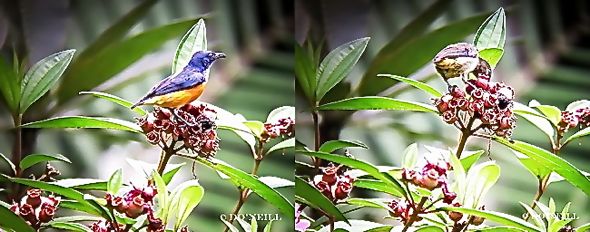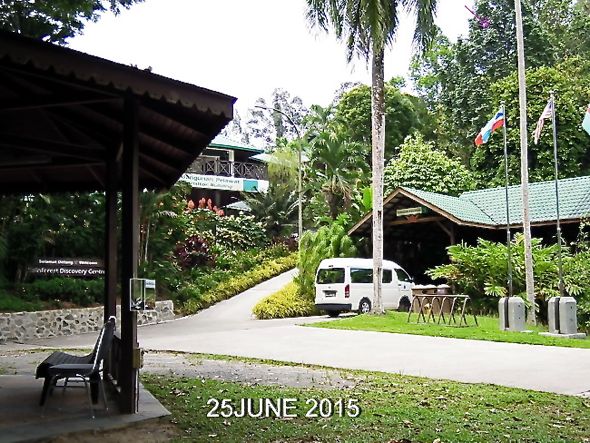“At first dawn light, I would be ready for the morning walk.
“The slightest sound of my footsteps on gravel path sent foraging green pigeons on a scrambling flight off a fig tree canopy. There were more than 20 of these birds feeding on ripened figs that looked like garlic bulbs with stems growing from branches in clusters.
“Infested tree foliages with many tiny holes accounted for several visiting insectivore bird species.
“Two pigeon species foraged on figs were identified as Little Green-pigeon (Treron olax) (above) and Pink-necked Green-pigeon (Treron vernans) (below-left).
“A female Lesser Green Leafbird (Chloropis cyanopogon) was a surprise find as day moved on (above-right).
“Bulbul species were in abundance especially Yellow-vented Bulbul (Pycnonotus goiavier) and a Buff-vented Bulbul (Iole olivacea) was observed preening after feeds (below-left).
“On a separate fig tree species, where individual figs sprouted from tree branches, a Spectacled Bulbul (Pycnonotus erythropthalmos) parent was observed feeding its chick (above-right).
“A burgundy-wine coloured, flowering bush with clusters of receptacle-like ovaries with exposed black juicy looking seeds, attracted a pair of Orange-bellied Flowerpeckers (Dicaeum trigonostigma) in lodging compound (above).
“Heading towards the Rain Forest Discovery Centre (RDC), an oil palm plantation opposite provided a source of energy foods for a family of Red-eyed Bulbuls (Pycnonotus brunneus) (above).
“The opposite sloped entrance of the Centre, a tall, fruiting tree caught my attention. It was studded with pink striped bell-shaped fruits of rose apple or jumbo bol (Syzygium malaccense) – the undersize of tennis balls (above).
“A family of Blue-eared Barbets (Megalaima australis) were gorging at the fruits (above).
“Bulbuls were never far away and here a Red-eyed Bulbul (Pycnonotus brunneus) shared the tree with the barbets (below-left).
Even the smallest endemic Yellow-rumped Flowerpecker (Prionochilus xanthopygius) was conspicuously discreet with his feeding and had a feeding area of his own (above-right).
“Evenings before dusk never got wasted. While energy and enthusiasm still remained, more surveys revealed secret foraging areas of the Asian Black Hornbills (Anthracoceros malayanus).
“Fruits of MacArthur Palm (Ptychosperma macarthuri) were on early dinner menu for a Hornbill pair (above, below).
“Fruits were gently plucked singularly with their enormous pincer bills. With precision, a sideway toss and catch in the air, had ripen fruits swallowed whole.”
Avian Writer Daisy O’Neill
Penang, Malaysia
Copyright article and all copies of bird images – Courtesy contribution from Daisy O’Neill Bird Conservation Fund.


![PLATE 1 LITTLE GREEN PIGEON [DaisyO'Neill]](https://besgroup.org/wp-content/uploads/PLATE-1-LITTLE-GREEN-PIGEON-DaisyONeill.jpg)
![PLATE 2 PNGP [DaisyO'Neill]](https://besgroup.org/wp-content/uploads/PLATE-2-PNGP-DaisyONeill.jpg)
![PLATE 3 Lesser green Leafbird [DaisyO'Neill]](https://besgroup.org/wp-content/uploads/PLATE-3-Lesser-green-Leafbird-DaisyONeill.jpg)
![PLATE 4 Buff-vented Bulbul [DaisyO'Neill]](https://besgroup.org/wp-content/uploads/PLATE-4-Buff-vented-Bulbul-DaisyONeill.jpg)
![PLATE 5 Spectacled Bulbul [DaisyO'Neill]](https://besgroup.org/wp-content/uploads/PLATE-5-Spectacled-Bulbul-DaisyONeill.jpg)



![PLATE 9 Blue-eared Barbetjv [DaisyO'Neill]](https://besgroup.org/wp-content/uploads/PLATE-9-Blue-eared-Barbetjv-DaisyONeill.jpg)
![PLATE 10 Red-eyed Bulbul [DaisyO'Neill]](https://besgroup.org/wp-content/uploads/PLATE-10-Red-eyed-Bulbul-DaisyONeill.jpg)
![PLATE 11 Yellow-rumped Flowerpecker [DaisyO'Neill]](https://besgroup.org/wp-content/uploads/PLATE-11-Yellow-rumped-Flowerpecker-DaisyONeill.jpg)








